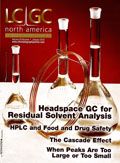Seeing in the New Year... or Making Sure the Old One Leaves
LCGC North America
By the time readers are opening the pages of this issue, we will all have turned the calendar on 2009 and left it behind for what will hopefully be a brighter 2010. Humorist Bill Vaughan once famously said of New Year's Eve: "An optimist stays up until midnight to see the new year in. A pessimist stays up to make sure the old year leaves." Given the financial year we all just experienced, my suspicion is there may be a few more people in the latter group than in the former this year. However, here at LCGC, we can't help but be optimistic about 2010.
By the time readers are opening the pages of this issue, we will all have turned the calendar on 2009 and left it behind for what will hopefully be a brighter 2010. Humorist Bill Vaughan once famously said of New Year's Eve: "An optimist stays up until midnight to see the new year in. A pessimist stays up to make sure the old year leaves." Given the financial year we all just experienced, my suspicion is there may be a few more people in the latter group than in the former this year. However, here at LCGC, we can't help but be optimistic about 2010.

David Walsh
One of the centerpieces of the upcoming year is undoubtedly the official launching of the CHROMacademy e-learning site and its corresponding social network, the CHROMmunity. Four industry-leading "Deans" head up the different sections of the academy, with LCGC veterans John Hinshaw, Ron Majors, and Michael Balogh in charge of the GC, Sample Prep, and MS sections, respectively, and 2009 LCGC Emerging Leader award winner Kevin Schug in charge of LC. In short, viewers will be learning from an all-star lineup of chromatographers, and the tutorials and learning modules offered on the site will be second to none in the field.
In addition, I often talk about LCGC's commitment to delivering content in as wide a variety of media as possible, making use of all of the content vehicles of the day. To this end, the CHOMmunity marks LCGC's formal entrance into the world of social media and networking. Far more than a simple group page on a larger network, the CHROMmunity is the premiere social network for chromatographers, bringing viewers cutting-edge technical discussions with industry colleagues, educational videos, the latest industry events, and more. I would invite readers to visit CHROMacademy at www.chromacademy.com at their earliest convenience and see everything the site has to offer. The site is up and running, and links to the CHROMmunity can be found there as well.
Whether you stayed up on New Year's Eve to welcome in 2010 or make sure 2009 left for good, there is a great deal in the world of separation science to look forward to in the coming year, and as usual, LCGC will be at the forefront, bringing you the latest developments in the field of chromatography.
So once again, on behalf of all of us at LCGC, Happy New Year. Here's hoping we will all be staying up to wish 2010 a fond goodbye next December 31st.

David Walsh
Editor-in-Chief

Determining Enhanced Sensitivity to Odors due to Anxiety-Associated Chemosignals with GC
May 8th 2025Based on their hypothesis that smelling anxiety chemosignals can, like visual anxiety induction, lead to an increase in odor sensitivity, a joint study between the University of Erlangen-Nuremberg (Erlangen, Germany) and the Fraunhofer Institute for Process Engineering and Packaging (Freising, Germany) combined behavioral experiments, odor profile analysis by a trained panel, and instrumental analysis of odorants (gas chromatography-olfactometry) and volatiles (gas chromatography-mass spectrometry).
Investigating 3D-Printable Stationary Phases in Liquid Chromatography
May 7th 20253D printing technology has potential in chromatography, but a major challenge is developing materials with both high porosity and robust mechanical properties. Recently, scientists compared the separation performances of eight different 3D printable stationary phases.
Detecting Hyper-Fast Chromatographic Peaks Using Ion Mobility Spectrometry
May 6th 2025Ion mobility spectrometers can detect trace compounds quickly, though they can face various issues with detecting certain peaks. University of Hannover scientists created a new system for resolving hyper-fast gas chromatography (GC) peaks.

.png&w=3840&q=75)

.png&w=3840&q=75)



.png&w=3840&q=75)



.png&w=3840&q=75)









